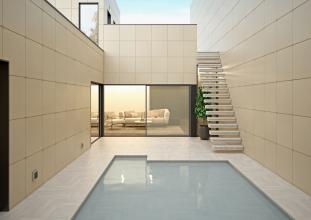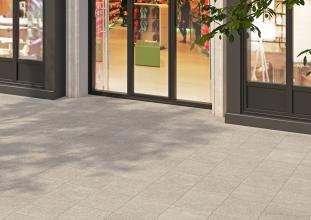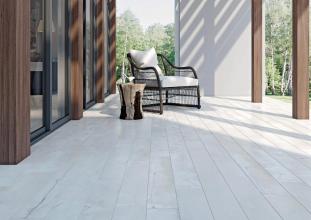The joint thickness is one of the most controversial issues concerning the tile laying. The cause of the arguments is the popularity of making no joints at all. We suggest you to figure out how to choose a ceramic tile for normal and jointless laying, and what joint thickness should be in either case.
While choosing gres, you can buy a tile, which cannot be laid without joints or you can stop on the cut tile, which is called rectified gres.
Gres for the normal and jointless laying
You can order usual gres tiles in other words non-rectified gres of any standard size, for example 600 × 600 mm. However, in practice, the actual physical size of the ordered tiles has been almost never equal to the given 600 × 600 mm. It can be slightly less or more than the standard, for example 597 × 597 mm or 604 × 604 mm.
This variation is not a defect because it is due to the technology of the gres production. At a very high firing temperature, the clay is baked differently, and as a result, produced ceramic tiles have slight variation in size.
The received material is sorted, taking into account the amount of deviation from the declared size, and is packed with the indication of the caliber. This indicator determines the difference of the actual size from the nominal, in other words, the caliber is the real parameter of the tile in mm.
When you decided to buy such tile, it is necessary to select packages with the tiles of one caliber, which is always indicated in the product’s nomenclature. In this case, you can level the small deviations in the size during laying, by the slight changing of the joint thickness.
If you install gres without joints, the changing of its thickness will not be possible, so it is more convenient to use rectified tiles instead of the usual calibrated gres. Such ceramic tile always comes in one size because after firing the gres is cut with the high-precision diamond equipment.
Choosing of the joint thickness
The customer always chooses the thickness of the tile joints, so the distance between the tiles is set by the design project. Earlier, the experts recommended making the thickness of the joint, which was 1% of the length of the tile’s larger side. However, under such conditions, for a 600 × 600 mm tile, joint thickness should be 6 mm. Today, the most common thickness size of intertile joint for the non-rectified gres is from 2,5 to 5 mm.
It is also possible to lay tiles with the formation of joint from 5 mm and more. Such decision may be due to the specificity of the interior, when its thickness and color play an important role and when they are the design elements.
Still, laying gres with a standard joint does not suit everyone, especially if you want to see on the floor and walls a monolithic pattern without straight and perpendicular lines. In such case, rectified tile of large size is used and the thickness of the joints is minimized with a manufacturer's recommended distance of 1,5-2 mm. The absence of chamfers and the large size of the tiles make a small intertile line almost invisible. Such method of the gres installation received the name of the jointless laying.
Formation of the joint during the gres installation
The joints are made using the tile spacers or with the help of the modern tile leveling systems.
• The tile spacers during laying are sometimes placed flat on the intersection of the tile joints. Even so, it is better to install them vertically, between the sides of the tiles. In this case, on each side of the tile put one or two spacers depending on tile size and laying scheme. For leveling of the first row and further correction of the joints use plastic tile wedges. Besides, for the formation of thick joints use special hollow cross spacers.
• Now it is more convenient to use so-called tile leveling system, for example Daz Leveling System (DLS) or use 3D-spacers, etc. This is a set of special wedges and clips, which help to level the position of two tiles relative to each other according to its height. The tile leveling system makes it easy to get an almost perfectly flat surface with the identical tile joints. After the adhesive has dried, tile spaces are taken out, and disposable clips of the leveling system are removed with a rubber hammer. The clips’ basis of the tile leveling system is staying under the tile.
Joint grouting during the gres installation
The pointing of the joints is carried out in one day after the gres tiles laying, when the adhesive will dry a little.
• During a conventional laying with joint of 3-5 mm, you can use inexpensive grouts for the gres, which are suitable by color and have a cement basis.
• In damp locations, epoxy grouts, which can withstand the effects of different liquids and chemicals, are used.
• When you make a thick joint with a width of 5 mm, it is better to choose the appropriate cement-sand and epoxy grouts especially for the gres tiles.
• To form the tile joints near the walls and other obstacles will help a silicone sealant.
Jointless gres installation
Principles of the jointless gres installation are generally like usual laying of the ceramic tiles, except that the requirements for the quality of the base and the adhesive mixture are even stricter.
• The surface for the tile laying must be absolutely leveled and has enough bearing capacity. Even minimal curvature and asperity can lead to the pressure inside the tile, as well as incomplete adhesion of the coating to the base layer on the surface. Moreover, as a result this will turn into cracks on the surface during the exploitation and may lead to a short service life of the covering.
• As already mentioned, it is better to choose a large-format gres tiles because this allows reducing the number of the joints.
• You should not save on the gres or on the adhesive mixture.
• During the work, a minimum joint of 1,5-2 mm is required to be used as a buffer in temperature fluctuations and high traffic. If you ignore this condition, in future exploitation, the tiles may crack.
• For grouting, use epoxy mixtures, which are selected in tone to the tile. Grout is applied over the entire depth of joint with a special rubber spatula.
• In large areas, special expansion joints should be provided. It will compensate the temperature variations and microvibration of the building and thus protect the floor covering from damage. Place the compensating expansion joint around the perimeter of the room, and in some cases, you can make a grid of such joints throughout the floor.



